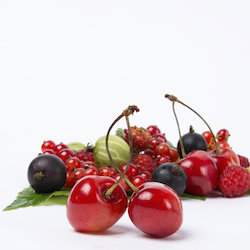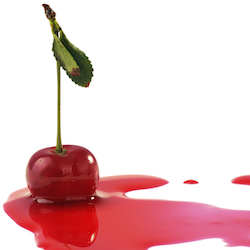The use of tart cherries for gout and joint pain has transitioned from a home remedy to a clinically supported treatment. In this study, published in Integrative Medicine A Clinician’s Journal, Cindy Alberta, MD examines whether the same biochemical reactions that reduce inflammation, pain and edema for gout and joint disorders could be useful for peripheral polyneuropathies. The following is an edited summary, plus the full report available for download.
Background on Tart Cherries for Peripheral Polyneuropathies
 The exact mechanism of action in tart cherries is unknown, but it is believed that acanthocyanin pigments and related bioflavonoids found in tart cherries and other red fruits scavenge free radicals, modulate cytokines, reduce DNA degradation, decrease capillary permeability, inhibit cyclooxygenase, and strengthen biological membranes.
The exact mechanism of action in tart cherries is unknown, but it is believed that acanthocyanin pigments and related bioflavonoids found in tart cherries and other red fruits scavenge free radicals, modulate cytokines, reduce DNA degradation, decrease capillary permeability, inhibit cyclooxygenase, and strengthen biological membranes.
Up to 9% of Americans over 50 years of age are affected by peripheral polyneuropathies. The causes vary from direct compression of peripheral nerves, toxic or metabolic injury to nerve tissue, autoimmune attack, or nutritional deficiency. However, as many as 30% patients have no identified cause.
In this study, presented at the 15th Annual Science and Clinical Application of Integrative Holistic Medicine, Dr. Carson makes the case for 4 ounces of tart cherry juice twice daily as a beneficial therapy without unwanted side effects.
Peripheral Polyneuropathies
The pathophysiology of polyneuropathies is complex and not fully understood, but 3 common patterns of damage occur:
- Distal axonopathy, where the cell bodies remain intact, but axons degenerate from distal to proximal, usually as the result of toxic or metabolic injury;
- Demyelination neuropathy, where damage to the myelin sheath from autoimmune, infectious, or other causes disrupts electrical signaling; and,
- Ganglionopathies, where damage occurs at the cell body or neuron, a relatively rare occurrence.
While weakness and loss of sensation are common in many peripheral polyneuropathies, “gain of function” symptoms, such as paresthesias and allodynia, are the most distressing and are very difficult to treat. It is believed that these symptoms are caused by alterations in ion channels, alterations in neurotransmitters and their receptors, and altered gene expression.
Common conventional treatments include antiepileptics, antidepressants, NSAIDs, and narcotics. These medications alter ion channels and neurotransmitters, decrease the sensitivity of nociceptive receptors, and desensitize C fibers. Most patients are on more than one of these medications but, even with polypharmacy and optimal dosing, only 40%-60% of patients report partial relief of symptoms, and many have significant adverse effects, such as somnolence, constipation, and drug dependence.
Objective / Tart cherry juice has been shown to be effective in the treatment of some inflammatory conditions and has a very low incidence of adverse effects. The purpose of this study was to determine whether tart cherry juice is an effective treatment for neuropathic pain from nondiabetic peripheral polyneuropathies.
Methods / The study group consisted of 12 primary care patient volunteers with painful lower extremity peripheral neuropathy. Patients with diabetic peripheral neuropathy were excluded due to the potentially confounding effect of the increased glycemic load from cherry juice. All study patients had carried a diagnosis of peripheral neuropathy for 5-10 y. All patients described 9-10 out of 10 pain more than 50% of the time. All study patients had been on multiple antiepileptics, analgesics, and antidepressants for more than 2 y without significant improvement of symptoms. All study patients were allowed to remain on their prescribed doses of gabapentin, pregabalin, SNRIs, tricyclics, and SSRIs during the study. The patients agreed not to use NSAIDs, steroids, lidocaine, and narcotic pain relievers during the study. There were no restrictions on diet or activity.
Presumed etiologies of the peripheral neuropathies in the study group were: 3 HIV, 2 chemotherapy-induced, 5 spinal disorders, and 2 idiopathic. All patients drank 4 oz of tart cherry juice 2 Å~/d for 14 d. The juice used was a combination of Prunus cerasus, Prunus acida, Prunus avium, and Prunus fructicosa, imported from the Caucasus and sold commercially as “100% cherry juice from concentrate.”
Results / After 14 d of treatment, the patients were questioned regarding the level of their peripheral neuropathy pain. Two patients (HIV and spinal DJD) reported no improvement. One patient with spinal DJD, 1 with spinal stenosis, and 1 with chemotherapy-induced pain reported a decrease of maximum pain to 5-8 of 10. Two patients with HIV, 1 with chemotherapy-induced pain, 1 with spinal stenosis, and 1 with idiopathic peripheral neuropathy reported a decrease of maximum pain to 2-4 of 10. One spinal stenosis patient and 1 idiopathic peripheral neuropathy patient reported a decrease of maximum pain to 0-1 of 10. Overall, more than 50% of the patients reported a greater than 50% reduction in maximum pain.
Conclusion / A 2-wk course of tart cherry juice significantly improved nondiabetic peripheral neuropathy in the majority of patients in the study. None of the patients reported any adverse effects from the treatment. The anti-inflammatory and analgesic effects of tart cherry, which have been seen in the treatment of arthritides, appear to be applicable to neuropathic pain as well, providing relief that is at least as good as conventional treatments, with no adverse effects.
This abstract was selected from posters presented at the 15th Annual Science and Clinical Application of Integrative Holistic Medicine, which took place October 26-30, 2014, in San Diego, California.
To gain access to this article and the rest of our extensive database of full-text articles, please register below or log in here.





